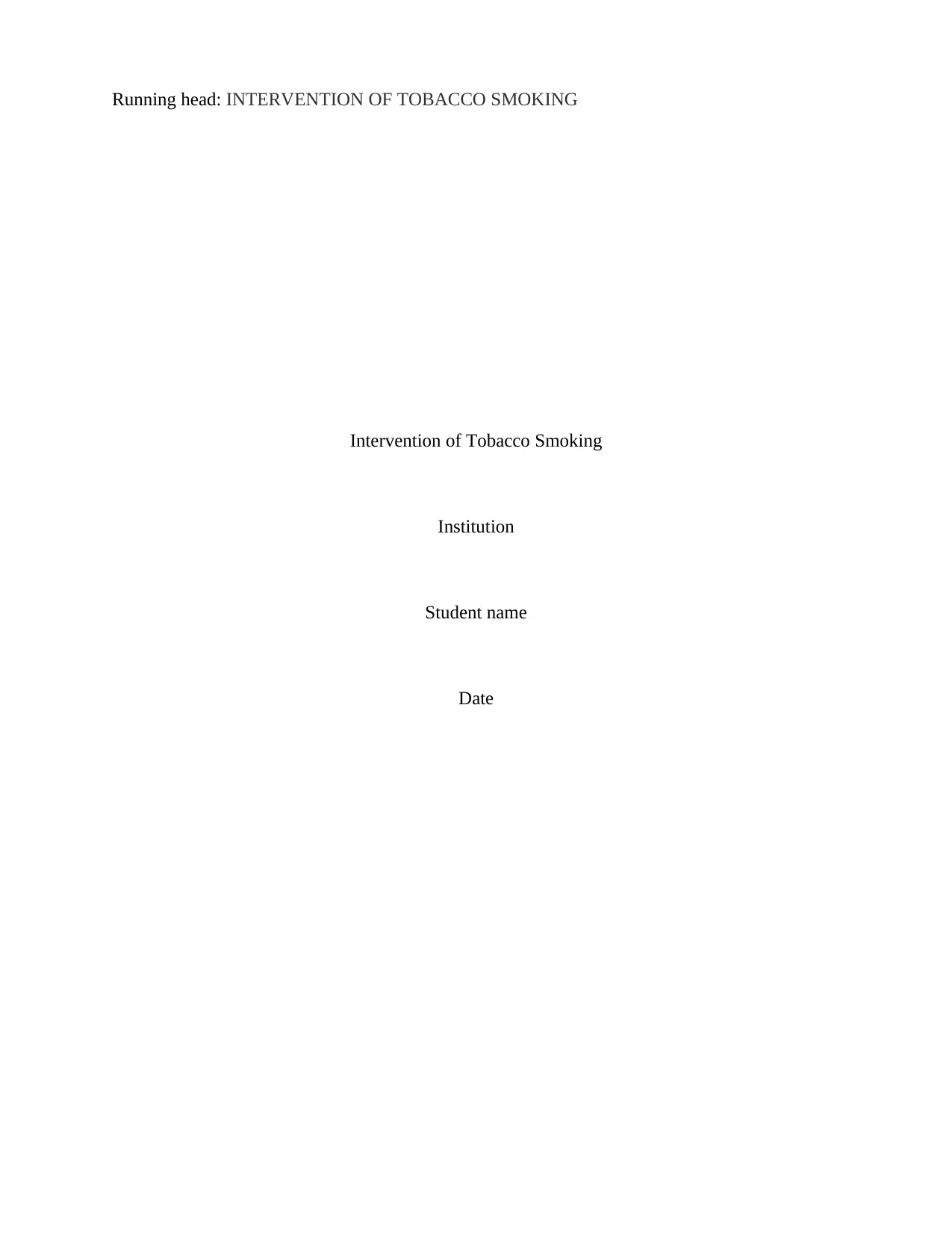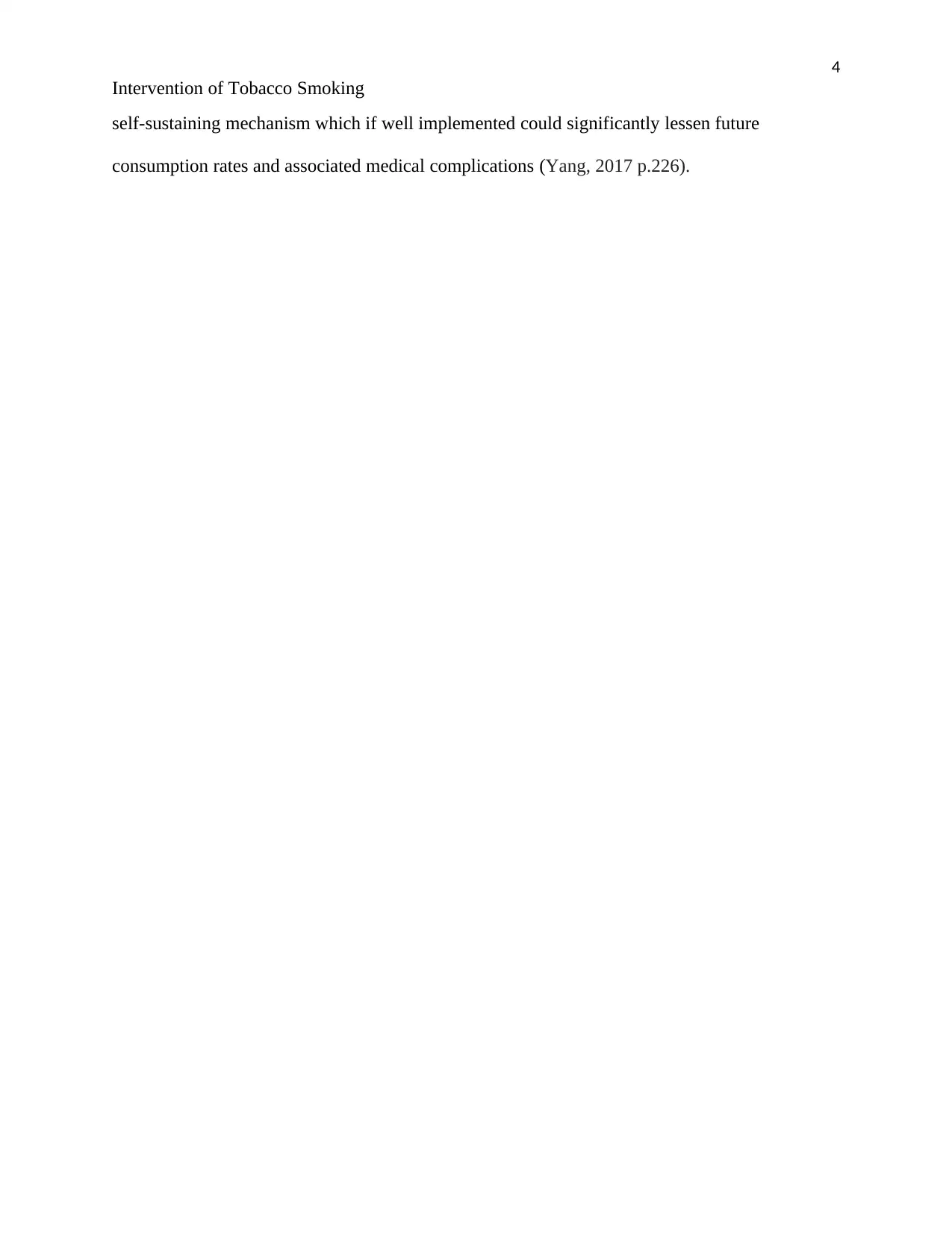Addressing Tobacco Smoking: A Population-Based Intervention Model
VerifiedAdded on 2023/05/28
|5
|1015
|389
Discussion Board Post
AI Summary
This discussion post examines tobacco smoking intervention strategies using a population-based model, encompassing upstream, midstream, and downstream approaches. The analysis highlights the severity of tobacco smoking as a major health risk, citing statistics on its prevalence and associated health consequences, including cancer, heart disease, and respiratory illnesses. The paper explores various intervention methods, such as group counseling, toll-free helplines, worksite initiatives, and tax increases on tobacco products, to reduce smoking rates and improve public health outcomes. It emphasizes the importance of addressing risky behaviors at both individual and population levels, advocating for comprehensive strategies to combat tobacco addiction and its detrimental effects on individuals and communities. The paper references several studies and research to support the effectiveness of the intervention strategies discussed.

Running head: INTERVENTION OF TOBACCO SMOKING
Intervention of Tobacco Smoking
Institution
Student name
Date
Intervention of Tobacco Smoking
Institution
Student name
Date
Paraphrase This Document
Need a fresh take? Get an instant paraphrase of this document with our AI Paraphraser

2
Intervention of Tobacco Smoking
Statistics show that twenty-five percent of the US adults are frequent users of tobacco
(Hollnagel, 2017). Tobacco smoking has been cited as one of the world’s all-time lethal killers.
The greatest side effect of smoking is cancer, a crazy development and spread of anomalous cells
that is now top among the world’s chronic ailments. Smoking makes one susceptible to the
danger of experiencing cardiac infections, lung complications, stroke, and other respiratory
sicknesses. The body develops terrible reactions to the conventional assault of smoking.
Smoking destroys the veins in limbs for instance, which leads to restricted flow of blood and
subsequently the removal of the appendages. Additionally, an addicted individual will, sooner or
later, begin experiencing eye irritations which prods visual damage. Noxious hair, foul breath
and even balding become imminent. These body reactions are as a result of perilous synthetic
substances contained in cigars. Until tobacco addiction is contained, more families will continue
to experience economic hardships sustaining the addiction and in worst cases grapple with the
loss of loved ones. This work presents an upstream, midstream, and downstream population-
based intervention model on how to effectively avert cigarette smoking at the population level.
Downstream intervention strategies are mechanisms that aim at changing existing
behaviors, through mass education and counseling members of the community that are currently
involved in risky behavioral practices (Hill et al., 2014). One particular cognitive-behavioral
interposition that has proven to be more effective is group counseling sessions where smokers
get to share their experiences on the challenges they may be facing in quitting tobacco. Toll-free
smoker helpline numbers can be distributed to groups and individuals so that they can gain a 24-
hour access to counseling services. Group counseling as Yang (2017) claims, are capable of
yielding up to 40 percent quit rates if they are properly combined with effective
Intervention of Tobacco Smoking
Statistics show that twenty-five percent of the US adults are frequent users of tobacco
(Hollnagel, 2017). Tobacco smoking has been cited as one of the world’s all-time lethal killers.
The greatest side effect of smoking is cancer, a crazy development and spread of anomalous cells
that is now top among the world’s chronic ailments. Smoking makes one susceptible to the
danger of experiencing cardiac infections, lung complications, stroke, and other respiratory
sicknesses. The body develops terrible reactions to the conventional assault of smoking.
Smoking destroys the veins in limbs for instance, which leads to restricted flow of blood and
subsequently the removal of the appendages. Additionally, an addicted individual will, sooner or
later, begin experiencing eye irritations which prods visual damage. Noxious hair, foul breath
and even balding become imminent. These body reactions are as a result of perilous synthetic
substances contained in cigars. Until tobacco addiction is contained, more families will continue
to experience economic hardships sustaining the addiction and in worst cases grapple with the
loss of loved ones. This work presents an upstream, midstream, and downstream population-
based intervention model on how to effectively avert cigarette smoking at the population level.
Downstream intervention strategies are mechanisms that aim at changing existing
behaviors, through mass education and counseling members of the community that are currently
involved in risky behavioral practices (Hill et al., 2014). One particular cognitive-behavioral
interposition that has proven to be more effective is group counseling sessions where smokers
get to share their experiences on the challenges they may be facing in quitting tobacco. Toll-free
smoker helpline numbers can be distributed to groups and individuals so that they can gain a 24-
hour access to counseling services. Group counseling as Yang (2017) claims, are capable of
yielding up to 40 percent quit rates if they are properly combined with effective

3
Intervention of Tobacco Smoking
pharmacotherapy. The figures may be even higher if the majority of the smoking population are
least addicted and have no psychiatric comorbidity.
The second part of the population-based model is the mid-stream interventions. This part
of the model concentrates considerably more on avoidance of unsafe practices, as opposed to
changing existing practices. It additionally centers on a lot more extensive gathering of
individuals, instead of little gatherings or individuals. It thus works with a simple formula of
encouraging new healthy behavior while discouraging risky ones. Worksite initiatives such as
subsidizing of insurance premiums for employees who do not smoke can be a nobble program.
Although not so widespread, the strategy is cost effective and greatly discourages those who may
be yearning to try smoking. If adopted countrywide, it can produce a bigger figure of quit rates
since the common US smoking population are engaged in some form of employment. The fact
that there is substantial financial gain associated with non-consumption of tobacco is a
motivation enough to quit smoking (Wiese, Piercey, & Clark, 2018).
Despite numerous failed attempts by the federal government to legislate tobacco control,
great milestones have been achieved upstream. The decision by the government to raise excise
duty on tobacco products has by far been the most successful. With smoking progressively
getting confined to low-income earners, the tobacco control network can easily gain an upper
hand in raising the taxes and subsequently the cost of cigarette (West et al., 2015). There is
starter proof that increments in the unit cost of tobacco may possibly decrease smoking-related
risk factors (Wray et al., 2017). This is because it does not encounter a lot of hurdles like other
upstream strategies. Furthermore, it is easier to implement and cost-effective. Revenues collected
from these tax hikes are used to fund tobacco control initiatives. The strategy thus presents a
Intervention of Tobacco Smoking
pharmacotherapy. The figures may be even higher if the majority of the smoking population are
least addicted and have no psychiatric comorbidity.
The second part of the population-based model is the mid-stream interventions. This part
of the model concentrates considerably more on avoidance of unsafe practices, as opposed to
changing existing practices. It additionally centers on a lot more extensive gathering of
individuals, instead of little gatherings or individuals. It thus works with a simple formula of
encouraging new healthy behavior while discouraging risky ones. Worksite initiatives such as
subsidizing of insurance premiums for employees who do not smoke can be a nobble program.
Although not so widespread, the strategy is cost effective and greatly discourages those who may
be yearning to try smoking. If adopted countrywide, it can produce a bigger figure of quit rates
since the common US smoking population are engaged in some form of employment. The fact
that there is substantial financial gain associated with non-consumption of tobacco is a
motivation enough to quit smoking (Wiese, Piercey, & Clark, 2018).
Despite numerous failed attempts by the federal government to legislate tobacco control,
great milestones have been achieved upstream. The decision by the government to raise excise
duty on tobacco products has by far been the most successful. With smoking progressively
getting confined to low-income earners, the tobacco control network can easily gain an upper
hand in raising the taxes and subsequently the cost of cigarette (West et al., 2015). There is
starter proof that increments in the unit cost of tobacco may possibly decrease smoking-related
risk factors (Wray et al., 2017). This is because it does not encounter a lot of hurdles like other
upstream strategies. Furthermore, it is easier to implement and cost-effective. Revenues collected
from these tax hikes are used to fund tobacco control initiatives. The strategy thus presents a
⊘ This is a preview!⊘
Do you want full access?
Subscribe today to unlock all pages.

Trusted by 1+ million students worldwide

4
Intervention of Tobacco Smoking
self-sustaining mechanism which if well implemented could significantly lessen future
consumption rates and associated medical complications (Yang, 2017 p.226).
Intervention of Tobacco Smoking
self-sustaining mechanism which if well implemented could significantly lessen future
consumption rates and associated medical complications (Yang, 2017 p.226).
Paraphrase This Document
Need a fresh take? Get an instant paraphrase of this document with our AI Paraphraser

5
Intervention of Tobacco Smoking
References
Hill, S., Amos, A., Clifford, D., & Platt, S. (2014). Impact of tobacco control interventions on
socioeconomic inequalities in smoking: review of the evidence. Tobacco
control, 23(e2), e89-e97.
Hollnagel, E. (2017). FRAM: the functional resonance analysis method: modelling complex
socio-technical systems. CRC Press.
West, R., Raw, M., McNeill, A., Stead, L., Aveyard, P., Bitton, J. & Borland, R. (2015). Health‐
care interventions to promote and assist tobacco cessation: a review of efficacy,
effectiveness and affordability for use in national guideline
development. Addiction, 110(9), 1388-1403.
Wiese, H. J. C., Piercey, R. R., & Clark, C. D. (2018). Changing prescribing behavior in the
United States: moving upstream in opioid prescription education. Clinical
Pharmacology & Therapeutics, 103(6), 982-989.
Wray, J. M., Funderburk, J. S., Acker, J. D., Wray, L. O., & Maisto, S. A. (2017). A meta-
analysis of brief tobacco interventions for use in integrated primary care. Nicotine and
Tobacco Research, 20(12), 1418-1426.
Yang, Q. (2017). Are social networking sites making health behavior change interventions more
effective? A meta-analytic review. Journal of health communication, 22(3), 223-233.
Intervention of Tobacco Smoking
References
Hill, S., Amos, A., Clifford, D., & Platt, S. (2014). Impact of tobacco control interventions on
socioeconomic inequalities in smoking: review of the evidence. Tobacco
control, 23(e2), e89-e97.
Hollnagel, E. (2017). FRAM: the functional resonance analysis method: modelling complex
socio-technical systems. CRC Press.
West, R., Raw, M., McNeill, A., Stead, L., Aveyard, P., Bitton, J. & Borland, R. (2015). Health‐
care interventions to promote and assist tobacco cessation: a review of efficacy,
effectiveness and affordability for use in national guideline
development. Addiction, 110(9), 1388-1403.
Wiese, H. J. C., Piercey, R. R., & Clark, C. D. (2018). Changing prescribing behavior in the
United States: moving upstream in opioid prescription education. Clinical
Pharmacology & Therapeutics, 103(6), 982-989.
Wray, J. M., Funderburk, J. S., Acker, J. D., Wray, L. O., & Maisto, S. A. (2017). A meta-
analysis of brief tobacco interventions for use in integrated primary care. Nicotine and
Tobacco Research, 20(12), 1418-1426.
Yang, Q. (2017). Are social networking sites making health behavior change interventions more
effective? A meta-analytic review. Journal of health communication, 22(3), 223-233.
1 out of 5
Related Documents
Your All-in-One AI-Powered Toolkit for Academic Success.
+13062052269
info@desklib.com
Available 24*7 on WhatsApp / Email
![[object Object]](/_next/static/media/star-bottom.7253800d.svg)
Unlock your academic potential
Copyright © 2020–2025 A2Z Services. All Rights Reserved. Developed and managed by ZUCOL.





